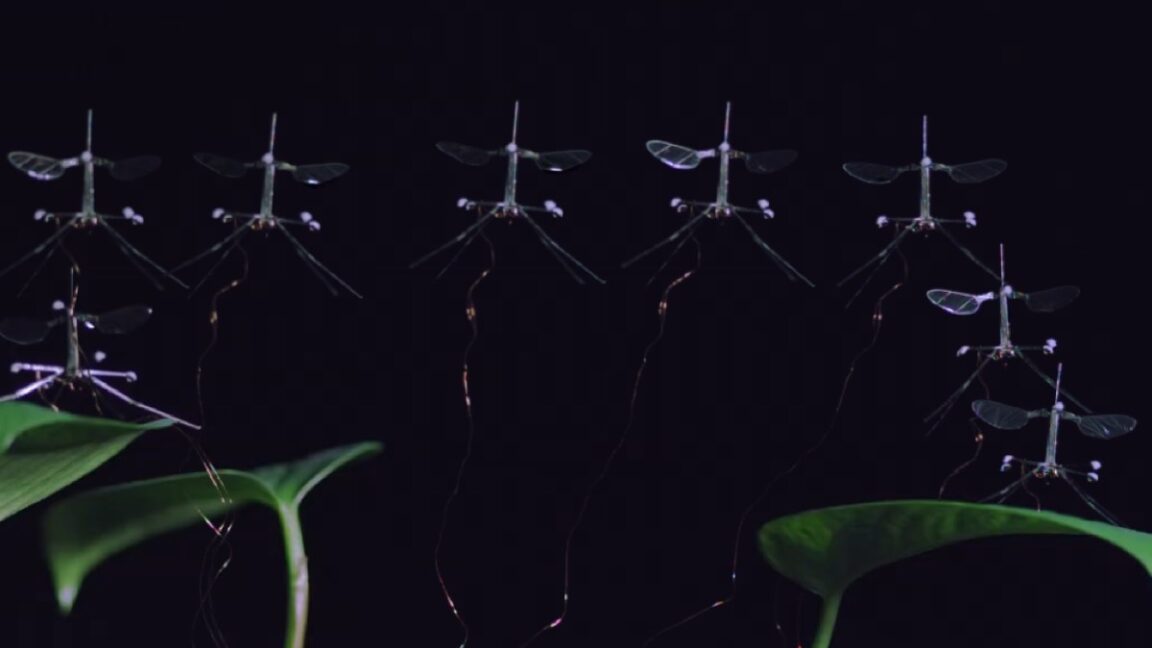
ARSTECHNICA.COM
RoboBee sticks the landing
nailed it
RoboBee sticks the landing
New robotic landing gear draws on the crane fly's unique appendages for landing on uneven surfaces.
Jennifer Ouellette
–
Apr 16, 2025 2:00 pm
|
3
Credit:
Harvard Microrobotics Laboratory
Credit:
Harvard Microrobotics Laboratory
Story text
Size
Small
Standard
Large
Width
*
Standard
Wide
Links
Standard
Orange
* Subscribers only
Learn more
The RoboBee lands on a leaf. Credit: Harvard Microrobotics Laboratory
Several years ago, Harvard University roboticist Robert Wood made headlines when his lab constructed RoboBee, a tiny robot capable of partially untethered flight. Over the years, RoboBee has learned to fly, dive, and hover. The latest improvement: RoboBee has learned how to stick the landing, thanks to biomechanical improvements to its landing gear modeled on the crane fly, which has a similar wingspan and body size to the RoboBee platform. The details of this achievement appear in a new paper published in the journal Science Robotics.
As previously reported, the ultimate goal of the RoboBee initiative is to build a swarm of tiny interconnected robots capable of sustained untethered flight—a significant technological challenge, given the insect-sized scale, which changes the various forces at play. In 2019, Wood's group announced its achievement of the lightest insect-scale robot so far to have achieved sustained, untethered flight—an improved version called the RoboBee X-Wing. In 2021, Wood's group turned its attention to the biomechanics of the mantis shrimp's knock-out punch and built a tiny robot to mimic that movement
But RoboBee was not forgotten, with the team focusing this time around on achieving more robust landings. “Previously, if we were to go in for a landing, we’d turn off the vehicle a little bit above the ground and just drop it, and pray that it will land upright and safely,” said co-author Christian Chan, one of Wood's graduate students. The trick is to minimize velocity when approaching a surface and then quickly dissipating impact energy. Even something as small and light as RoboBee can generate significant impact energy. The crane fly has long, jointed appendages that enable them to dampen their landings, so the insect served as a useful model for RoboBee's new landing gear.
The RoboBee is only slightly larger than a penny.
Credit:
Harvard Microrobotics Laboratory
The first step was to perform experiments to determine the effects of oscillation on the newly designed robotic legs and leg joints. This involved manually disturbing the leg and then releasing it, capturing the resulting oscillations on high-speed video. This showed that the leg and joint essentially acted as an "underdamped spring-mass-damper model," with a bit of "viscoelastic creep" for good measure. Next, the team performed a series of free-fall experiments with small fiberglass crash-test dummy vehicles with mass and inertia similar to RoboBee's, capturing each free fall on high-speed video. This was followed by tests of different takeoff and landing approaches.
The final step was running experiments on consecutive takeoff and landing sequences using RoboBee, with the little robot taking off from one leaf, hovering, then moving laterally before hovering briefly and landing on another leaf nearby. The basic setup was the same as prior experiments, with the exception of placing a plant branch in the motion capture arena. RoboBee was able to safely land on the second leaf (or similar uneven surfaces) over repeated trials with varying parameters.
Going forward, Wood's team will seek to further improve the mechanical damping upon landing, drawing lessons from stingless bees and mosquitoes, as well as scaling up to larger vehicles. This would require an investigation into more complex leg geometries, per the authors. And RoboBee still needs to be tethered to off-board control systems. The team hopes one day to incorporate onboard electronics with built-in sensors.
“The longer-term goal is full autonomy, but in the interim we have been working through challenges for electrical and mechanical components using tethered devices,” said Wood. “The safety tethers were, unsurprisingly, getting in the way of our experiments, and so safe landing is one critical step to remove those tethers.” This would make RoboBee more viable for a range of practical applications, including environmental monitoring, disaster surveillance, or swarms of RoboBees engaged in artificial pollination.
Science Robotics, 2025. DOI: 10.1126/scirobotics.adq3059 (About DOIs).
Jennifer Ouellette
Senior Writer
Jennifer Ouellette
Senior Writer
Jennifer is a senior writer at Ars Technica with a particular focus on where science meets culture, covering everything from physics and related interdisciplinary topics to her favorite films and TV series. Jennifer lives in Baltimore with her spouse, physicist Sean M. Carroll, and their two cats, Ariel and Caliban.
3 Comments
0 التعليقات
0 المشاركات
63 مشاهدة


